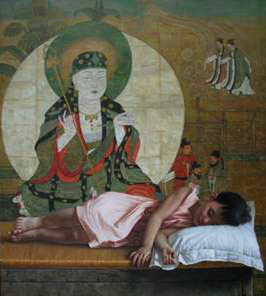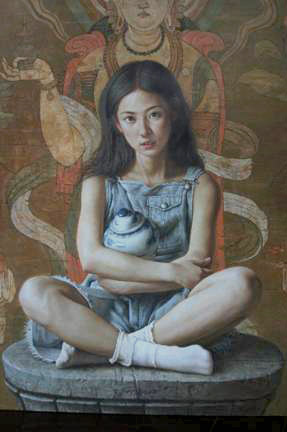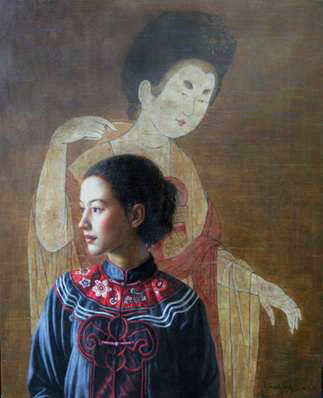

In Sleeping Child with Loan, Gu places a quietly slumbering girl in a pink sundress under a Ming Dynasty (1368-1644) wall painting of a Tibetan monk or lohan (enlightened being). The lohan depicted may be Yunqi Zhuhong (1535-1615), who advocated the attempt to integrate the most important non-controversial aspects of Confucianism, Buddhism, and Daoism. This transcendent being appears to watch over the child as she sleeps, caught in that blissful state of non-being that dreamless slumber brings and the state an enlightened being ultimately seeks to attain.


One of the myriad manifestations of Tara -- the ever-popular Tibetan Buddhist goddess of universal compassion -- hovers over the lovely young girl featured in Gu Zhinong's Girl with Ginger Jar. The effigy of this deity, which holds a vessel in her right hand as she sits imperturbably on a lotus flower, dates to the Yuan Dynasty (1280-1368). Tara, which means "star" in Sanskrit, represents virtuous and enlightened action. Her compassion for living beings is said to be stronger than a mother's love for her children. She also brings about longevity, protects earthly travel and guards her followers on their spiritual journey to enlightenment. Gu's youthful sitter, clad in modern Western denim overalls and white socks, clutches a blue and white lidded ginger jar 9 symbolic of her upcoming life to her chest as she gazes placidly at her audience; she replicates the cross-legged position of the benevolent goddess behind her. A latter-day Tara, she suggests the continuity, reincarnation and eternal connection at the core of Buddhist teachings and contemporary Chinese society.
A ferocious Chinese folk art Door God stands vigilant guard over Child with Flowered Hat, in which a charming child of perhaps four or five, attired in an embroidered smock with frilly sleeves and carved jade amulet, poses demurely against the backdrop of this colorful Chinese grass-roots icon from the Qing Dynasty (1644-1912). She sports an American-style baseball cap festooned with flowers in imitation of the divine guardian behind her.



Eyes focused in opposite directions, the arresting subject of Gu Zhinong's Girl in Traditional Chinese Dress and one of the female courtiers appearing in renowned Tang Dynasty painter Zhou Fang's Palace Ladies Wearing Flowered Headdresses could be considered a study in both physical and psychological disparity. Zhou's plump, pampered imperial court lady in a sensually diaphanous gown, made-up face and intricate coiffure decorated with flowers and jewels stands in sharp contrast to the unspoiled natural beauty and modesty of Gu's pensively meditative sitter.
Perhaps the most intriguing painting of the group, Contemporary Transcendence captures a loin cloth-draped male as a halo-crowned, Buddha-like figure, levitating above a painted backdrop of a lotus pedestal flanked by two 17th century Ming Dynasty attendants. One cannot ignore the similarity between the artist's decidedly Buddha-positioned central figure and Renaissance Christian iconography of St. Sebastian, albeit without arrows piercing his flesh.


| Verna Glancy | Director |
| Verna@ContemporaryChineseFineArt.com |
|
|
|
|
| www.contemporarychinesefineart.com |
Copyright 2007, Contemporary Chinese Fine Art. All rights reserved.